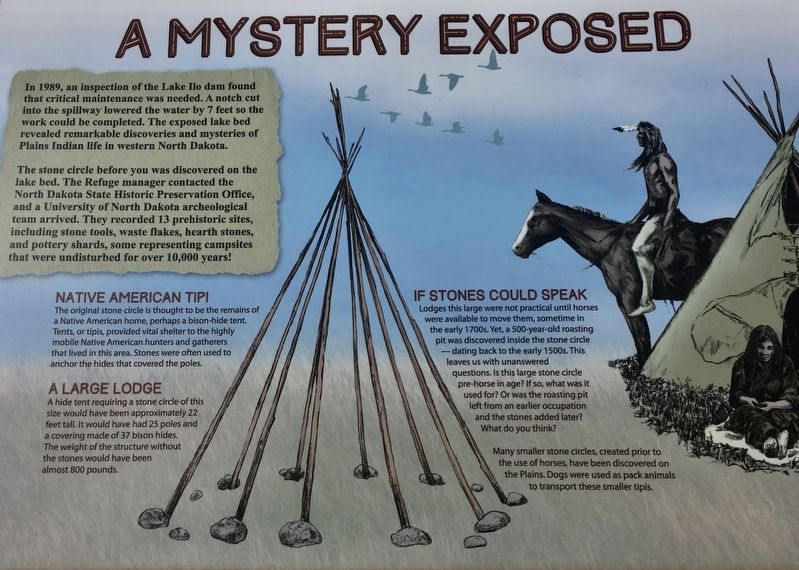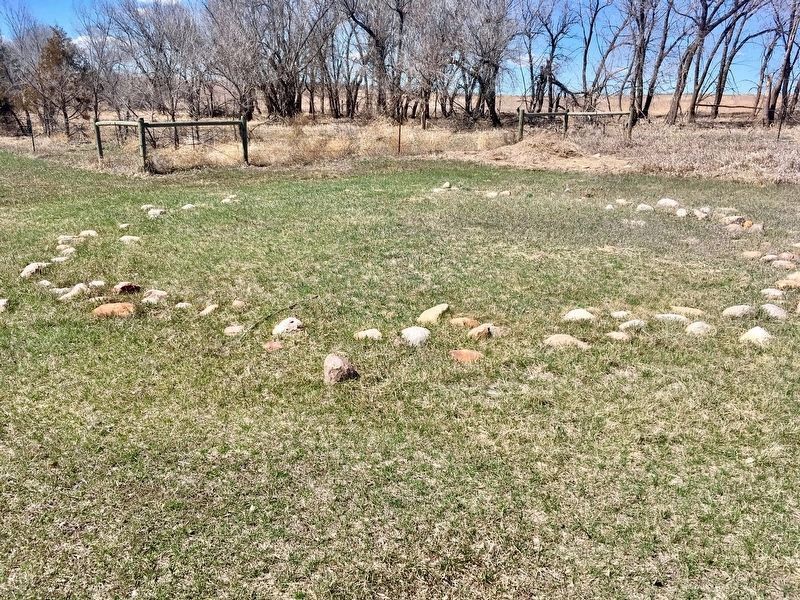Near Dunn Center in Dunn County, North Dakota — The American Midwest (Upper Plains)
A Mystery Exposed
In 1989, inspection of the Lake Ilo dam found that critical maintenance was needed. A notch cut into the spillway lowered the water about 7 feet so the work could be completed. The exposed lake bed revealed remarkable discoveries and mysteries of Plains Indian life in western North Dakota.
The stone circle before you was discovered on the lake bed the Refuge manager contacted the North Dakota State Historic Preservation Office, and the University of North Dakota archaeological team arrived. They recorded 13 prehistoric sites, including stone tools, waste flakes, hearth stones, and pottery shards, some representing campsites that were undisturbed for over 10,000 years!
Native American Tipi
The original stone circle is thought to be the remains of a Native American home, perhaps a bison-hide tent. Tents, or tipis, provided vital shelter to the highly mobile Native American hunters and gatherers that lived in this area. Stones are often used to anchor the hides the covered the poles.
A Large Lodge
A hide tent requiring a stone circle of this size would have been a proximately 22 feet tall. It would have had 25 poles and a covering made of 37 bison hides. The weight of the structure without the stones would have been almost 800 pounds.
If Stones Could Speak
Lodges this large were not practical until horses were available to move them, sometime in the early 1700s. Yet, a 500-year-old roasting pit was discovered inside the stone circle — dating back to the early 1500s. This leaves us with unanswered questions. Is this large stone circle pre-horse in age? If so, what was it used for? Or was the roasting pit left from an earlier occupation and stones added later? What do you think?
Many smaller stone circles, created prior to the use of horses, have been discovered on the Plains. Dogs were used as pack animals to transport these smaller tipis.
Erected by Fish and Wildlife Service.
Topics. This historical marker is listed in these topic lists: Anthropology & Archaeology • Native Americans. A significant historical year for this entry is 1989.
Location. 47° 21.126′ N, 102° 39.219′ W. Marker is near Dunn Center, North Dakota, in Dunn County. Marker can be reached from Fourth Street Southwest east of Olson Lane. Touch for map. Marker is in this post office area: Dunn Center ND 58626, United States of America. Touch for directions.
Other nearby markers. At least 1 other marker is within walking distance of this marker. Chelsey and Polly Dinkins Memorial Dam (approx. half a mile away).
Also see . . . Lake Ilo National Wildlife Refuge. North Dakota Parks website entry (Submitted on December 30, 2021, by Larry Gertner of New York, New York.)
Credits. This page was last revised on December 30, 2021. It was originally submitted on July 18, 2020, by Connor Olson of Kewaskum, Wisconsin. This page has been viewed 390 times since then and 37 times this year. Photos: 1, 2. submitted on July 18, 2020, by Connor Olson of Kewaskum, Wisconsin. • Mark Hilton was the editor who published this page.
Editor’s want-list for this marker. A wide shot of the marker and its surroundings. • Can you help?

